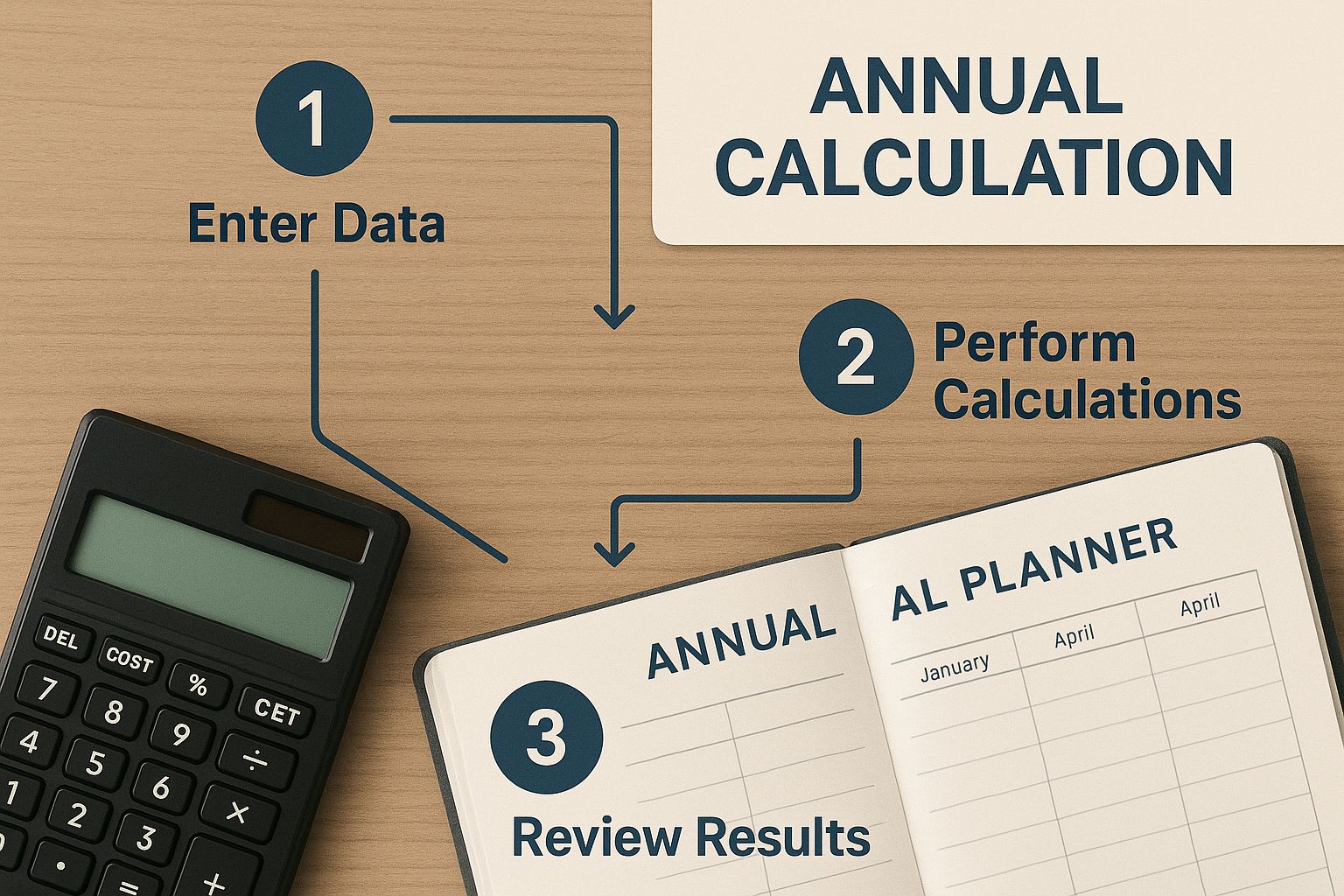
Ask anyone to guess the number of hours in a work year, and you’ll likely hear 2080. It’s the standard figure, born from a simple calculation: 40 hours a week times 52 weeks. But let’s be honest—that number rarely matches reality.
Especially in places like the Netherlands, where work-life balance is a cornerstone of the culture, the actual time spent working is almost always lower. Once you factor in public holidays, paid time off (PTO), and individual contract details, the picture changes significantly. This guide will walk you through exactly how to calculate your own annual hours, so you have a practical number you can use for planning.
Your Quick Guide to Calculating Annual Work Hours
Figuring out your true annual work hours isn't as daunting as it sounds. It’s a straightforward process of subtraction. You start with the maximum possible hours and then deduct all the time you’re not expected to be working. What’s left is a far more accurate and actionable total for planning your projects and workload.
It can be helpful to first figure out how many working days in a year (UK Edition) and then convert those days into hours. This gives you a solid foundation before you start subtracting your specific leave days.
The Basic Calculation Formula
To calculate your annual hours, you'll need three key pieces of information from your employment contract:
- Your contracted weekly hours.
- Your total annual leave days.
- The list of public holidays your company observes.
Here’s the formula:
- Gross Annual Hours: Multiply your weekly hours (e.g., 40) by 52. This gives you the maximum possible hours you could work in a year.
- Public Holidays: Next, identify which public holidays fall on your normal workdays and subtract the corresponding hours.
- Paid Time Off (PTO): Finally, deduct your entire annual leave allowance. This includes the legal minimum plus any extra days your company offers.
The key is to move from a generic total to a personalised one. That 2080-hour figure is just a starting point, not the final answer for your unique situation.
This final number represents your net working hours—the figure that actually matters for planning projects and understanding your workload.
To get a feel for how this works in practice, here’s a simplified breakdown for a typical full-time employee in the Netherlands.
Calculating a Typical Dutch Work Year
| Calculation Step | Example Hours |
|---|---|
| Gross Annual Hours (40 hrs × 52 wks) | 2,080 |
| Less: Public Holidays (avg. 8 days × 8 hrs) | -64 |
| Less: Statutory Annual Leave (20 days × 8 hrs) | -160 |
| Less: Employer-Offered Leave (avg. 5 days × 8 hrs) | -40 |
| Total Net Working Hours | 1,816 |
As you can see, the real number is often hundreds of hours less than the standard 2080.
Getting a handle on this helps you manage your time much more effectively. If you want to stay on top of your projects and track your time against your annual total, a good planner can make all the difference. Check out our guide on using a template project planner in Excel to get started.
Why the Dutch Approach to Work Is Different

There’s a reason the Netherlands consistently scores high for work-life balance, and it’s not by chance. It comes from a deep-seated cultural belief that your personal time is just as vital as your professional time. This philosophy shapes everything from employment laws to daily schedules.
This mindset creates a work environment where the goal is to get the job done well, not to stay chained to your desk. As a result, the standard 40-hour workweek is less of a given here, with many full-time contracts set at 36 or 38 hours.
The Power of Part-Time Work
What really sets the Dutch approach apart is how normal and accepted part-time work is. In some cultures, working fewer hours might be seen as a lack of ambition, but here it's a respected choice for a huge part of the workforce, regardless of profession.
This flexibility is a major reason why the average number of hours in a Dutch work year is so much lower. It allows people to better organise their lives around family, hobbies, or continuing their education.
This cultural shift toward valuing personal time shows up in the national statistics. The focus is on being productive during work hours, which helps people [https://whatpulse.pro/blog/2024-11-05-find-balance-be-more-productive] overall.
The data backs this up. In 2023, the average Dutch employee worked around 1,449 hours. That’s a massive drop from the peak of 1,802 hours back in 1971 and sits well below the global average. It’s a clear sign of how laws and cultural norms have created a healthier integration of work and life.
Cultural Nuances and Holidays
To get an accurate picture of annual work hours in the Netherlands, you have to understand this context. The emphasis on time off isn't just about a generous holiday allowance; it’s about respecting national celebrations and collective downtime. To get a feel for this, it's worth checking out a guide to Netherlands Public Holidays.
Full-Time vs Part-Time Hours: What’s the Dutch Standard?

Before you can calculate your work year, the first thing to pin down is your contract type. In the Netherlands, the term "full-time" isn't as rigid as you might think. This flexibility is a big deal, and it's the first variable that will change your total annual hours.
Depending on your industry and its collective labour agreement (CAO), a full-time contract could mean 40, 38, or even 36 hours a week. That might not sound like a massive difference, but over a year, it really adds up. It changes the entire baseline of your calculation before you even think about holidays.
The Part-Time Norm
What truly sets the Dutch labour market apart is how common and accepted part-time work is. It’s not just a stopgap or a temporary solution like in many other countries. Here, it’s a respected, long-term career choice for a huge part of the workforce.
This cultural preference dramatically skews the national average. While a full-time employee works around 39.2 hours a week, the average for the entire workforce, part-timers included, is just 32.1 hours. You can get a deeper look into the Dutch approach to working hours over at iamexpat.nl.
It’s all part of a system designed to give people a real chance to balance their work and personal lives.
The popularity of part-time roles isn't a minor detail; it's a core piece of the Dutch work-life philosophy. This makes it absolutely essential to check your own contract instead of relying on a generic number.
How Different Contracts Compare
Let’s put some numbers to this to see how it plays out in the real world. When you project these different work arrangements over a year, the contrast becomes obvious.
Here’s a quick look at the gross annual hours before any leave is taken out:
- 40-Hour Full-Time Contract: This is the traditional setup, giving you a baseline of 2,080 gross hours a year.
- 36-Hour Full-Time Contract: A popular alternative, especially in the public sector, which comes out to 1,872 gross hours.
- 24-Hour Part-Time Contract: A very common part-time schedule, resulting in 1,248 gross hours.
Getting a handle on these baselines is the first real step to finding your own annual total. The key is to ignore assumptions and start with the exact hours stated in your contract. Once you know your starting point, you can begin to optimise work patterns with data transparency and make sure every hour counts.
How Holidays and Leave Impact Your Annual Hours
The simple formula of multiplying your weekly hours by 52 gives you a starting point, but it's not the real number of hours you'll actually work. To get an accurate picture, you have to subtract all the time you're not working. Think of it this way: your gross annual hours are a full tank of fuel, but public holidays and annual leave are the trips you take that use it up. What's left is what you actually have for the journey of work.
These days off aren't just suggestions; they are non-negotiable deductions from your total. Let's get that number from a vague estimate down to something you can actually use.
https://www.youtube.com/embed/RzOYTQm8MKo
Accounting for Dutch Public Holidays
The Netherlands has a number of official public holidays each year, but here’s a crucial detail: not all of them will fall on a workday. You only need to subtract the holidays that land on a day you would have otherwise been at your desk, typically Monday to Friday.
For a full-time employee, that means you'll subtract eight hours for each of those days. The public holidays most people get off are:
- New Year's Day (Nieuwjaarsdag)
- Good Friday (Goede Vrijdag) - Note: this isn't a mandatory day off for everyone.
- Easter Monday (Tweede Paasdag)
- King's Day (Koningsdag)
- Ascension Day (Hemelvaartsdag)
- Whit Monday (Tweede Pinksterdag)
- Christmas Day (Eerste Kerstdag)
- Boxing Day (Tweede Kerstdag)
Understanding Your Annual Leave
In the Netherlands, annual leave is broken down into two distinct categories. You need to account for both to get your final calculation right.
1. Statutory Vacation Days (Wettelijke Vakantiedagen): This is the legal minimum everyone is entitled to, no exceptions. The law states this must be at least four times the number of hours you work per week. So, if you're on a standard 40-hour contract, that's a guaranteed 160 hours off, which works out to 20 days.
2. Non-Statutory Vacation Days (Bovenwettelijke Vakantiedagen): This is the extra stuff. It’s any additional leave your employer offers on top of that legal minimum. The amount can vary quite a bit from one company to another and will be spelled out in your employment contract or Collective Labour Agreement (CAO). It's common for employers to offer an additional 4-5 days.
By subtracting both the public holidays that fall on a workday and your full leave entitlement, you move from a generic guess to a precise, personal figure. This final number isn't just a statistic; it's your true annual workload.
Calculate Your Personal Work Year Step-by-Step
Alright, let's get personal and figure out your exact number. This simple, four-step process will take you from a vague estimate to a precise figure you can actually use for planning. Think of it like tuning an instrument—you start with the basic notes and then make small adjustments until it’s perfectly in key with your real-life situation.
The whole process is really just a journey of subtraction. You start with the maximum possible hours in a year and then start chipping away all your scheduled time off.
This infographic gives you a quick visual guide for how the annual calculation works.

As you can see, each step refines the total, making sure you account for every type of leave you're entitled to.
The Four-Step Calculation
To figure out how many hours are in your work year, you’ll just need your employment contract and a calculator.
- Find Your Weekly Hours: First, look at your contract. This is your foundation. Are you on a 40, 38, 36-hour week, or something else?
- Calculate Gross Annual Hours: Multiply your weekly hours by 52 (the number of weeks in a year). So, if you're on a 36-hour contract, your starting point is 1,872 hours.
- Subtract Public Holidays: Next, count up the official public holidays that fall on days you’d normally be working. If seven holidays land on your workdays, you'll subtract 56 hours (7 days × 8 hours).
- Deduct Your Annual Leave: Finally, subtract your paid holiday time. If your contract gives you 25 days of leave, you’ll take off another 200 hours (25 days × 8 hours).
Following this method, someone on a 36-hour week would have a net work year of 1,616 hours (1,872 - 56 - 200). That’s a far more accurate number for personal and professional planning than a generic baseline.
To make it even clearer, here’s a quick comparison of what the final numbers look like for a few common contract types in the Netherlands after factoring in typical leave.
Estimated Annual Work Hours by Contract Type
| Contractual Weekly Hours | Estimated Annual Work Hours |
|---|---|
| 40-Hour Contract | ~1,816 Hours |
| 36-Hour Contract | ~1,616 Hours |
| 24-Hour Contract | ~1,048 Hours |
As you can see, the difference between the 'gross' hours and the actual hours you're expected to work is significant. It's a calculation well worth doing.
Once you’ve got a handle on your personal work year, a few other questions tend to pop up. Getting these details right is especially important for navigating the unique way things work in the Dutch labour market.
So, where does overtime fit in? That’s probably the most common question. In the Netherlands, overtime is almost always handled separately from your contracted hours. It won’t be part of that initial annual calculation we did. Instead, your compensation—whether that’s extra pay or time off in lieu—will be laid out in your employment contract or Collective Labour Agreement (CAO).
Navigating Special Circumstances
What if you start a new job in the middle of the year? Your annual hours are simply calculated on a pro-rata basis. It sounds technical, but it just means you work out the total hours for the rest of the year, starting from the day you join.
For instance, if you land a 40-hour-per-week job and start on 1 July, you’d calculate your hours for the 26 weeks left in the year. From there, you just subtract any public holidays and the paid leave you’ll earn during that time.
It's also worth knowing about the legal side of things.
The Netherlands takes work-life balance seriously, and it's all baked into the Working Hours Act (Arbeidstijdenwet). This law puts firm limits on daily and weekly work, making sure people don’t get overworked.
By law, you can't work more than 12 hours in a single shift or more than 60 hours in one week. And while there’s a bit of flexibility for short periods, your weekly average can’t go over 48 hours when measured across 16 weeks.
This legal safety net is a huge reason why the average Dutch workweek is one of the shortest in the world. The country’s strong support for part-time work, particularly for working parents, also plays a big role in bringing the average annual hours down. You can learn more about the cultural and legal factors shaping the Dutch four-day workweek on Fortune.com. All these protections make calculating a work year a predictable and fair process for everyone involved.
Ready to gain deeper insights into your team's work patterns? WhatPulse provides privacy-first analytics to help you understand application usage, focus time, and productivity trends without ever capturing sensitive data. Discover how WhatPulse can help your organisation at whatpulse.pro.
Start a free trial